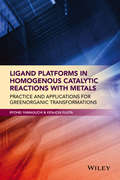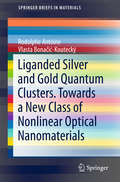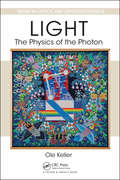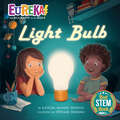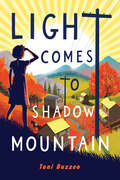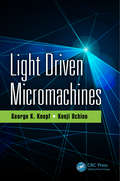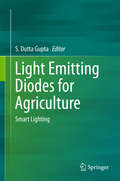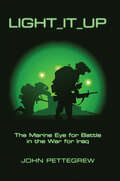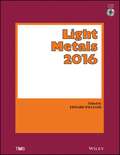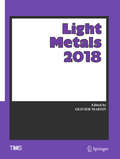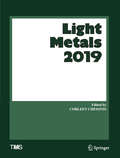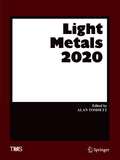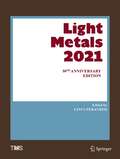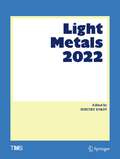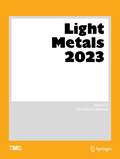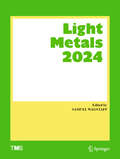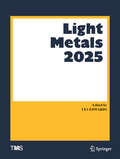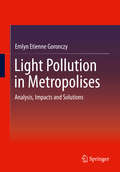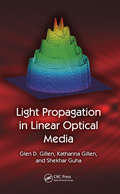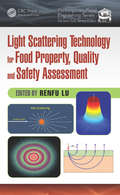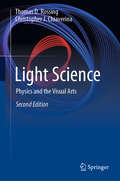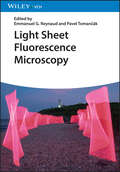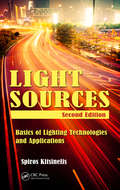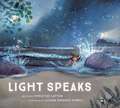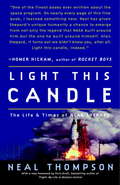- Table View
- List View
Ligand Platforms in Homogenous Catalytic Reactions with Metals: Practice and Applications for Green Organic Transformations
by Ryohei Yamaguchi Ken-ichi FujitaServing as a user's manual for synthetic organic and catalytic chemists, this book guides chemists in the design and choice of ligands to catalyze organic reactions and apply the results for more efficient, green, and practical synthesis. • Focuses on the role of ligands in metal complexes that catalyze green organic transformations: a hot topic in the area of organic synthesis and green chemistry • Offers a comprehensive resource to help readers design and choose ligands and understand selectivity/reactivity characteristics • Addresses a gap by taking novel ligand approaches and including up-to-date discussion on hydrogen transfers and reactions • Presents important industrial perspective and provides rational explanations of ligand effects, impacts, and novelty
Liganded silver and gold quantum clusters. Towards a new class of nonlinear optical nanomaterials (SpringerBriefs in Materials)
by Rodolphe Antoine Vlasta Bonačić-KouteckýMetallic quantum clusters belonging to intermediate size regime between two and few hundred of atoms, represent unique building blocks of new materials. Nonlinear optical (NLO) characteristics of liganded silver and gold quantum clusters reveal remarkable features which can be tuned by size, structure and composition. The two-photon absorption cross sections of liganded noble metal quantum clusters are several orders of magnitude larger than that of commercially-available dyes. Therefore, the fundamental photophysical understanding of those two-photon processes in liganded clusters with few metal atoms deserve special attention, in particularly in context of finding the mechanisms responsible for these properties. A broad range of state-of-the-art experimental methods to determine nonlinear optical properties (i.e. two-photon absorption, two-photon excited fluorescence and second harmonic generation) of quantum clusters are presented. The experimental setup and underlying physical concepts are described. Furthermore, the theoretical models and corresponding approaches are used allowing to explain the experimental observations and simultaneously offering the possibility to deduce the key factors necessary to design new classes of nanoclusters with large NLO properties. Additionally, selected studied cases of liganded silver and gold quantum clusters with focus on their NLO properties will be presented as promising candidates for applications in imaging techniques such as fluorescence microscopy or Second-Harmonic Generation microscopy.
Light - The Physics of the Photon (Series in Optics and Optoelectronics)
by Ole KellerFrom the early wave-particle arguments to the mathematical theory of electromagnetism to Einstein's work on the quantization of light, different descriptions of what constitutes light have existed for over 300 years. Light - The Physics of the Photon examines the photon phenomenon from several perspectives. It demonstrates the importance of studyin
Light Bulb: Eureka! The Biography of an Idea (Eureka! The Biography of an Idea)
by Kathleen Weidner ZoehfeldElectric lights--without them, we'd be in the dark! Here is a "biography" of the light bulb, an essential invention that lights up our days and nights.From the first spark of Thomas Alva Edison's idea to the spread of electric lights around the world, Light Bulb is a fun and informative look at an invention that makes a huge difference in our lives. This STEAM nonfiction title is part of the new Eureka! series, each book covering one groundbreaking, world-changing discovery that millions of people use every single day.
Light Comes to Shadow Mountain
by Toni BuzzeoCora Mae Tipton is determined to light up her Appalachian community in this historical fiction novel from an award-winning author and former librarian.It&’s 1937 and the government is pushing to bring electricity to the mountains of southeastern Kentucky. It&’s all Cora can think of; radios with news from around the world, machines that keep food cold, lightbulbs by which to read at night! Cora figures she can help spread the word by starting a school newspaper and convincing her neighbors to support the Rural Electrification Act.But resistance to change isn&’t easy to overcome, especially when it starts at home. Cora&’s mother is a fierce opponent of electrification. She argues that protecting the landscape of the holler—the trees, the streams, the land that provides for their way of life—is their responsibility. But Cora just can&’t let go of wanting more. Lyrical, literary, and deeply heartfelt, this debut novel from an award-winning author-librarian speaks to family, friendship, and loss through the spirited perspective of a girl eager for an electrified existence, but most of all, the light of her mother&’s love and acceptance.Back matter includes an Author&’s Note; further information on the Rural Electrification Act, the herbs and plants of Appalachia, the Pack Horse Library Project, and more; and a &“Quick Questions&” historical trivia section for readers.A Junior Library Guild Gold Standard Selection
Light Driven Micromachines
by Kenji Uchino George K. KnopfIn Light Driven Micromachines, the fundamental principles and unique characteristics of light driven material structures, simple mechanisms and integrated machines are explored. Very small light driven systems provide a number of interesting features and unique design opportunities because streams of photons deliver energy into the system and provide the control signal used to regulate the response of the micron sized device. Through innovative material design and clever component fabrication, these optically powered tiny machines can be created to perform mechanical work when exposed to varying light intensity, wavelength, phase, and/or polarization. The book begins with the scientific background necessary to understand the nature of light and how light can initiate physical movement by inducing material deformation or altering the surrounding environment to impose micro-forces on the actuating mechanisms. The impact of physical size on the performance of light driven mechanisms and machines is discussed, and the nature of light–material interactions is reviewed. These interactions enable very small objects and mechanical components to be trapped and manipulated by a focused light beam, or produce local temperature gradients that force certain materials to undergo shape transformation. Advanced phase transition gels, polymers, carbon-based films and piezoelectric ceramics that exhibit direct light-to-mechanical energy conversion are examined from the perspective of designing optically driven actuators and mechanical systems. The ability of light to create photothermal effects that drive microfluidic processes and initiate the phase transformation of temperature sensitive shape memory materials are also explored in the book. This compendium seeks to inspire the next generation of scientists and engineers by presenting the fundamental principles of this emerging interdisciplinary technology and exploring how the properties of light can be exploited for microfluidic, microrobotic, biomedical and space applications.
Light Emitting Diodes for Agriculture
by S Dutta GuptaThis book presents a comprehensive treatise on the advances in the use of light-emitting diodes (LEDs) for sustainable crop production and describes the latest photomorphogenesis research findings. It introduces readers to the fundamentals and design features of LEDs applicable for plant growth and development and illustrates their advantages over the traditional lighting systems, including cost analyses. Further, it discusses a wide range of applications covering diverse areas of plant sciences relevant to controlled environment agriculture and in vitro plant morphogenesis. The chapters have been written by a team of pioneering international experts, who have made significant contributions to this emerging interdisciplinary field. The book will serve a valuable resource for graduate students, instructors, and researchers in the fields of horticulture, agricultural biotechnology, cell and developmental biology, and precision agriculture. It will also serve well profe ssionals engaged in greenhouse and vertical farming.
Light It Up: The Marine Eye for Battle in the War for Iraq
by John PettegrewExamines the U.S. Marines’ visual culture of combat in the Iraq War.American military power in the War on Terror has increasingly depended on the capacity to see the enemy. The act of seeing—enhanced by electronic and digital technologies—has separated shooter from target, eliminating risk of bodily harm to the remote warrior, while YouTube videos eroticize pulling the trigger and video games blur the line between simulated play and fighting.Light It Up examines the visual culture of the early twenty-first century military. Focusing on the Marine Corps, which played a critical part in the invasion and occupation of Iraq, John Pettegrew argues that U.S. military force in the Iraq War was projected through an "optics of combat." Powerful military technology developed in the Iraq and Afghanistan wars has placed war in a new posthuman era.Pettegrew’s interviews with marines, as well as his analysis of first-person shooter videogames and combat footage, lead to startling insights into the militarization of popular digital culture. An essential study for readers interested in modern warfare, policy makers, and historians of technology, war, and visual and military culture.
Light Metals 2016
by The Minerals, Metals & Materials SocietyThe 2016 collection will include papers from the following symposia: Alumina and Bauxite Aluminum Alloys, Processing, and Characterization Aluminum Reduction Technology Cast Shop Technology Electrode Technology Strip Casting
Light Metals 2018 (The Minerals, Metals & Materials Series)
by Olivier MartinThe Light Metals symposia at the TMS Annual Meeting & Exhibition present the most recent developments, discoveries, and practices in primary aluminum science and technology. The annual Light Metals volume has become the definitive reference in the field of aluminum production and related light metal technologies. The 2018 collection includes papers from the following symposia: 1. Alumina and Bauxite 2. Aluminum Alloys, Processing, and Characterization 3. Aluminum Reduction Technology 4. Cast Shop Technology 5. Cast Shop Technology: Energy Joint Session 6. Cast Shop Technology: Fundamentals of Aluminum Alloy Solidification Joint Session 7. Cast Shop Technology: Recycling and Sustainability Joint Session 8. Electrode Technology for Aluminum Production 9. Perfluorocarbon Generation and Emissions from Industrial Processes 10. Scandium Extraction and Use in Aluminum Alloys
Light Metals 2019 (The Minerals, Metals & Materials Series)
by Corleen ChesonisThe Light Metals symposia at the TMS Annual Meeting & Exhibition present the most recent developments, discoveries, and practices in primary aluminum science and technology. The annual Light Metals volume has become the definitive reference in the field of aluminum production and related light metal technologies. The 2019 collection includes papers from the following symposia: 1. Alumina and Bauxite 2. Aluminum Alloys, Processing, and Characterization 3. Aluminum Reduction Technology 4. Cast Shop Technology 5. Cast Shop Technology: Energy Joint Session 6. DGM-TMS Symposium on Lightweight Metals 7. Electrode Technology for Aluminum Production 8. REWAS 2019: Cast Shop Recycling Technologies 9. Scandium Extraction and Use in Aluminum Alloys 10. Ultrasonic Processing of Liquid and Solidifying Alloys
Light Metals 2020 (The Minerals, Metals & Materials Series)
by Alan TomsettThe Light Metals symposia at the TMS Annual Meeting & Exhibition present the most recent developments, discoveries, and practices in primary aluminum science and technology. The annual Light Metals volume has become the definitive reference in the field of aluminum production and related light metal technologies. The 2020 collection includes papers from the following symposia: • Alumina and Bauxite• Aluminum Alloys, Processing and Characterization• Aluminum Reduction Technology• Cast Shop Technology• Cast Shop Technology: Recycling and Sustainability Joint Session• Electrode Technology for Aluminum Production
Light Metals 2021: 50th Anniversary Edition (The Minerals, Metals & Materials Series)
by Linus PeranderThe Light Metals symposia at the TMS Annual Meeting & Exhibition present the most recent developments, discoveries, and practices in primary aluminum science and technology. The annual Light Metals volume has become the definitive reference in the field of aluminum production and related light metal technologies. The 2021 collection includes contributions from the following symposia: · Alumina and Bauxite · Aluminum Alloys, Processing, and Characterization · Aluminum Reduction Technology · Aluminum Reduction Technology Across the Decades: An LMD Symposium Honoring Alton T. Tabereaux, Halvor Kvande and Harald A. Øye · Cast Shop Technology · Electrode Technology for Aluminum Production
Light Metals 2022 (The Minerals, Metals & Materials Series)
by Dmitry EskinThe Light Metals symposia at the TMS Annual Meeting & Exhibition present the most recent developments, discoveries, and practices in primary aluminum science and technology. The annual Light Metals volume has become the definitive reference in the field of aluminum production and related light metal technologies. The 2022 collection includes contributions from the following symposia: • Alumina and Bauxite • Aluminum Alloys, Processing and Characterization • Aluminum Reduction Technology • Aluminum Reduction Technology Joint Session with REWAS: Decarbonizing the Metals Industry • Cast Shop Technology • Electrode Technology for Aluminum Production • Primary Aluminum Industry—Energy and Emission Reductions: An LMD Symposium in Honor of Halvor Kvande • Recycling and Sustainability in Cast Shop Technology: Joint Session with REWAS 2022
Light Metals 2023 (The Minerals, Metals & Materials Series)
by Stephan BroekThe Light Metals symposia at the TMS Annual Meeting & Exhibition present the most recent developments, discoveries, and practices in primary aluminum science and technology. The annual Light Metals volume has become the definitive reference in the field of aluminum production and related light metal technologies. The 2023 collection includes contributions from the following symposia: · 60 Years of Taking Aluminum Smelting Research and Development from New Zealand to the World: An LMD Symposium in Honor of Barry J. Welch · Alumina & Bauxite · Aluminium Industry Emissions Measurement, Reporting & Reduction · Aluminium Waste Management & Utilisation · Aluminum Alloys, Characterization and Processing · Aluminum Reduction Technology · Cast Shop Technology · Electrode Technology for Aluminum Production · Scandium Extraction and Use in Aluminum Alloys
Light Metals 2024 (The Minerals, Metals & Materials Series)
by Samuel WagstaffThe Light Metals symposia at the TMS Annual Meeting & Exhibition present the most recent developments, discoveries, and practices in primary aluminum science and technology. The annual Light Metals volume has become the definitive reference in the field of aluminum production and related light metal technologies. The 2024 collection includes contributions from the following symposia: · Alumina & Bauxite · Aluminum Alloys: Development and Manufacturing · Aluminum Reduction Technology · Electrode Technology for Aluminum Production · Melt Processing, Casting and Recycling · Scandium Extraction and Use in Aluminum Alloys
Light Metals 2025 (The Minerals, Metals & Materials Series)
by Les EdwardsThe Light Metals symposia at the TMS Annual Meeting & Exhibition present the most recent developments, discoveries, and practices in primary aluminum science and technology. The annual Light Metals volume has become the definitive reference in the field of aluminum production and related light metal technologies. The 2025 collection includes contributions from the following symposia: Alumina & Bauxite Aluminum Alloys: Development and Manufacturing Aluminum Reduction Technology Decarbonization and Sustainability in Aluminum Primary Processing: Joint Session of Aluminum Reduction, Electrode Technology, and REWAS 2025 Electrode Technology for Aluminum Production Melt Processing, Casting and Recycling Recycling and Sustainability in Cast Shop Technology: Joint Session with REWAS 2025 Scandium Extraction and Use in Aluminum Alloys
Light Pollution in Metropolises: Analysis, Impacts and Solutions
by Emlyn Etienne GoronczyLight pollution (light smog, light pollution or light emissions) is a fundamental problem in metropolises with effects on flora, fauna and people. Accordingly, the first section of the book discusses the basics of light pollution and its effects on various organisms. The characteristics of light smog in the cities of Hanover, Warsaw, Boston, New York City and Toronto are then analysed and compared. But how can the problem be tackled? Existing measures for the prevention of light pollution are discussed and further novel approaches are shown by comparing the metropolises. The book is aimed primarily at practitioners in this field and helps to identify sources of emissions and identify suitable reduction measures. This book is a translation of the original German edition „Lichtverschmutzung in Metropolen“ by Emlyn Etienne Goronczy, published by Springer Fachmedien Wiesbaden GmbH in 2018. The translation was done with the help of artificial intelligence (machine translation by the service DeepL.com). A subsequent human revision was done primarily in terms of content, so that the book will read stylistically differently from a conventional translation. Springer Nature works continuously to further the development of tools for the production of books and on the related technologies to support the authors.
Light Propagation in Linear Optical Media
by Shekhar Guha Glen D. Gillen Katharina GillenLight Propagation in Linear Optical Media describes light propagation in linear media by expanding on diffraction theories beyond what is available in classic optics books. In one volume, this book combines the treatment of light propagation through various media, interfaces, and apertures using scalar and vector diffraction theories. After covering the fundamentals of light and physical optics, the authors discuss light traveling within an anisotropic crystal and present mathematical models for light propagation across planar boundaries between different media. They describe the propagation of Gaussian beams and discuss various diffraction models for the propagation of light. They also explore methods for spatially confining (trapping) cold atoms within localized light-intensity patterns. This book can be used as a technical reference by professional scientists and engineers interested in light propagation and as a supplemental text for upper-level undergraduate or graduate courses in optics.
Light Scattering Technology for Food Property, Quality and Safety Assessment (Contemporary Food Engineering)
by Renfu LuLight Scattering Technology for Food Property, Quality and Safety Assessment discusses the development and application of various light scattering techniques for measuring the structural and rheological properties of food, evaluating composition and quality attributes, and detecting pathogens in food. The first four chapters cover basic concepts, principles, theories, and modeling of light transfer in food and biological materials. Chapters 5 and 6 describe parameter estimation methods and basic techniques for determining optical absorption and scattering properties of food products. Chapter 7 discusses the spatially-resolved measurement technique for determining the optical properties of food and biological materials, whereas Chapter 8 focuses on the time-resolved spectroscopic technique for measuring optical properties and quality or maturity of horticultural products. Chapter 9 examines practical light scattering techniques for nondestructive quality assessment of fruits and vegetables. Chapter 10 presents the theory of light transfer in meat muscle and the measurement of optical properties for determining the postmortem condition and textural properties of muscle foods and meat analogs. Chapter 11 covers the applications of spatially-resolved light scattering techniques for assessing quality and safety of animal products. Chapter 12 looks into light scattering for milk and dairy processing. Chapter 13 examines the applications of dynamic light scattering for measuring the microstructure and rheological properties of food. Chapter 14 shows the applications of a biospeckle technique for assessing the quality and condition of fruits and vegetables. Chapter 15 provides a detailed description of Raman scattering spectroscopic and imaging techniques in food quality and safety assessment. Chapter 16, the final chapter, focuses on applications of light scattering techniques for the detection of food-borne pathogens.
Light Science: Physics and the Visual Arts (Undergraduate Texts In Contemporary Physics Ser.)
by Thomas D. Rossing Christopher J. ChiaverinaIntended for students in the visual arts and for others with an interest in art, but with no prior knowledge of physics, this book presents the science behind what and how we see. The approach emphasises phenomena rather than mathematical theories and the joy of discovery rather than the drudgery of derivations. The text includes numerous problems, and suggestions for simple experiments, and also considers such questions as why the sky is blue, how mirrors and prisms affect the colour of light, how compact disks work, and what visual illusions can tell us about the nature of perception. It goes on to discuss such topics as the optics of the eye and camera, the different sources of light, photography and holography, colour in printing and painting, as well as computer imaging and processing.
Light Sheet Fluorescence Microscopy
by Emmanuel G. Reynaud Pavel TomančákLight Sheet Fluorescence Microscopy An indispensable guide to a novel, revolutionary fluorescence microscopy technique! Light sheet fluorescence microscopy has revolutionized microscopy, since it allows scientists to perform experiments in an entirely different manner and to record data that had not been accessible before. With contributions from noted experts in the fields of physics, biology, and computer science, Light Sheet Fluorescence Microscopy is a unique guide that offers a practical approach to the subject, including information on the basics of light sheet fluorescence microscopy, instrumentation, applications, sample preparation, and data analysis. Comprehensive in scope, the book is filled with the cutting-edge methods as well as valuable insider tips. Grounded in real-world applications, the book includes chapters from major manufacturers that explores their recent systems and developments. In addition, the book hightlights a discussion of a “do-it-yourself” light sheet microscope, making the technique affordable for every laboratory. This important textbook: Serves as an easy-to-understand introduction to light sheet-based fluorescence Includes numerous tips and tricks for advanced practitioners Provides in-depth information on hardware and software solutions for a straightforward implementation of light sheet fluorescence microscopy in the lab Includes chapters from the major manufacturers including Zeiss, Leica, Lavision Biotech, Phase View, and Asi Aimed at cell biologists, biophysicists, developmental biologists, and neuro-biologists, Light Sheet Fluorescence Microscopy offers a comprehensive overview of the most recent applications of this microscopy technique.
Light Sources: Basics of Lighting Technologies and Applications
by Spiros Kitsinelis Spyridon KitsinelisDecide Which Lighting Technology Is Best for Your ApplicationLight Sources, Second Edition: Basics of Lighting Technologies and Applications presents an overview of the three main technologies that have produced the numerous families of lighting products on the market today: electrical incandescence, electrical gas discharges, and semiconductor lig
Light Speaks
by Christine LaytonSpare, lovely text and gorgeous, color-saturated illustrations make a compelling presentation. An enchanting picture book about the joyful, mysterious, awe-inspiring messages of light, whether emanating from a firefly or the sun, fireworks or the Big Bang, boats at sea or a bolt of lightning, a movie projector or a rainbow. Luciana Navarro Powell’s illustrations follow a group of kids through a magical day and evening in a seacoast town, while Christine Layton’s lyrical text explores the natural history of light. Backmatter provides further adventures in the science of light.
Light This Candle: The Life and Times of Alan Shepard
by Neal ThompsonAlan Shepard was the brashest, cockiest, and most flamboyant of America's original Mercury Seven, but he was also regarded as the best. Intense, colorful, and dramatic, he was among the most private of America's public figures and, until his death in 1998, he guarded the story of his life zealously. Light This Candle, based on Neal Thompson's exclusive access to private papers and interviews with Shepard's family and closest friends--including John Glenn, Wally Schirra, and Gordon Cooper--offers a riveting, action-packed account of Shepard's life.
